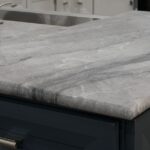Granite countertops are durable, long-lasting, and very resistant to scratches. However, they are only resistant to stains and easy to clean when properly sealed.
Due to stones being naturally porous, liquids can be absorbed into these pores and stain your beautiful countertop surface. To ensure that’s not ever going to happen with you, in this article we will share all you need to know about how to seal granite countertops. Starting with the basics.
Do you want to know more about granite countertops? We’ve got the perfect article for you: the definitive guide on granite countertops.
Why sealing granite countertops is important?
Porosity is the real villain here. And there’s no way to walk away from it since it’s normal in most natural materials. Actually, by choosing granite you already made sure you have one of the less porous materials in your kitchen. By the way, great choice!
But what is porosity anyway? It is a measure of the amount of pores (tiny holes) in a given material or surface. This quality is directly related to the liquid absorption rating of that material.
Think about it like this, the more and the bigger the holes a surface has on it, the more liquid it will suck in. And in most cases, especially in your kitchen, liquids being sucked in equals stains.
Thus sealing, filling and covering the holes (pores) on your granite, is precisely the solution we’re looking for to lead happy and calm lives while trusting our countertops can handle liquids spills (what they need to do all the time).
Now not all granite varieties require sealing, some are really naturally impervious (the opposite of porous), especially the dark ones. And because of that, there’s no way to define a periodicity of sealing valid for all types of stone.
That said, it’s important that you know exactly when and if it’s time to seal your granite countertops.
The “Should I Seal My Stone Countertops” 30 Minute Test
Yes, it’s that fast, and it doesn’t get any easier. And before you think about it, sealing a stone that doesn’t require sealing “just to be sure” is not a great idea!
Remember sealants fill and cover pores? If no pores are open, you’re just wasting money and possibly damaging your surface for no good reason. Excessive exposition to sealant might make a granite countertop hazy.

This really simple test will save you from all that. And more, you can do it right now, since you’ve definitively got all the necessary ingredients at home.
Drip a puddle of water and another of cooking oil in your stone top and observe it while keeping track of the time. We should probably mention that it’s safer if you select an area of your countertop that’s normally covered or hidden in order to do it.
- If it darkens in up to 10 minutes, you need urgent sealing.
- If it takes 15 minutes to darken, you should also reseal it, but maybe only one coating of sealant will be enough.
- If it takes 30 minutes to darken, or if it doesn’t darken at all, there’s no need to seal your countertop for now.
It’s as simple as that, now you don’t need to trust anyone’s opinion on the matter. If your countertop is sucking liquids, it’s time to make it water and oil repellent again. We will teach what to do.
Choose the right sealant
No brand is sponsoring this post, so you can trust we will give you actual info into how to choose the best product yourself.
Optimally, we’re looking for a sealant that will go deep inside the surface of the material, ensuring that it will resist stains and keep out bacterias for longer. We’re not looking for a cheaper product whose effects won’t last for more than 2 months.
Here are some characteristics of long-lasting granite sealants:
- Impregnating type, rather than topical or penetrating
- Designed for stone countertops, even better if specially for granite
- Able to cover at least 160 square feet per quart
- Able to repel both water-based liquids and oil
- Able to dry without changing the stone color
By choosing a premium sealant you will be able to enjoy a protected granite countertop for years.
How to Seal Granite Countertops
Well, the best way to go about this part is to strictly adhere to the instructions found on the product you purchased. However, we will share a step by step guide of how to seal granite countertops that will give you a general idea of what the process is like.
Plus we added a lot of safety and precaution measures you should definitely add to your procedure too.
Step 1: Cleaning
Thoroughly clean your granite countertop either with a mild neutral detergent or with a stone specific cleaner. That is to ensure no residues will interfere with the penetration of the impregnating sealer.
Some people add a second clean up with denatured or isopropyl alcohol just to be sure. If doing so, remember to wear hand protection, those are strong chemicals.
Step 2: Let it dry
Before continuing, the granite surface must be allowed to dry thoroughly. We recommend giving it a complete 24 hours waiting time. It goes without saying that the countertop must not be used during this time. That would make a second cleaning necessary.
The drying time can be reduced to 8 hours if a strong breeze is blowing across it.
After the stone is cleaned and dry, we can begin the sealing process.
Step 3: Preparation
Again, before you start you need to take all necessary health precautions. Including wearing hand protection, keeping the application area ventilated, and reading the material safety data sheet.
Another caution step you should probably implement is performing the procedure that comes next, on a small area of your countertop first. Preferably one that’s hidden. Then only proceeding to the whole surface once you’re sure the selected product reacted well with your granite variety.
Step 4: Applying the sealant
If the sealant comes in a spray bottle, use it to apply the liquid to the whole countertop, including edges and backsplashes. If it doesn’t, apply it to a dry lint-free cloth and use it to spread the sealant.
You don’t need to soak your countertop, but make sure the entire surface in damp.
Allow the first coat to dry for the amount of time required on the instructions. Usually 10 to 20 minutes. Then apply a second coating.
Once the second coating dries, wipe the remaining residues from the countertop and the process is completed. You need only wait.
Step 5: Wait for the cure time
Your granite countertop is only completely repellant and food safe after you wait for the requiring cure time. 24 to 48 hours depending on the product. After that, you’re ready to go.
Now you know exactly how to seal granite countertops, and how to find out if it’s time to do it again. Perform the test we taught you regularly and keep your granite counters always safe.
If you think doing it yourself is too much trouble, or you just don’t have the time, you can count on Eagle Stones to help. Get in touch!



